The Mountain Warriors
In February, the U.S. Army sent an elite group of mountaineers to represent the United States at an international military competition. Here’s why the team came from Vermont.
The wind was howling through the notch. As the storm blew through the cliff-lined granite corridor, eight soldiers dressed in standard-issue Army camouflage squared their chests and kept moving, kicking and gliding across the snow on lightweight touring skis.
Their objective was to ski the 20 kilometers from the Route 108 road closure near Smuggler’s Notch on the Jeffersonville side, up Spruce Peak, down to Stowe Mountain Resort, back up Mt. Mansfield, down the Bruce Trail and back over to Stevensville in about four hours. My plan was to accompany them, part way.
The conditions were brutal. The wind whipped cold crystals of snow that stung exposed skin. Once we turned off of Route 108, the untracked snow in the trees was covered in an unyielding rain crust. The leader, Army Mountain Warfare School Instructor Tim McLaughlin, set a skin track that climbed straight up the steep, wooded terrain.
Moving at a brisk pace, the eight soldiers—all members of the Army and Army National Guard—chatted amicably, checking in with each other in the storm. The soldier behind me mumbled through his balaclava to another, “Hey, how are those blisters?” From behind came the answer, “Not so bad, I’m trying a new way of taping them.” The group moved seamlessly as a unit.
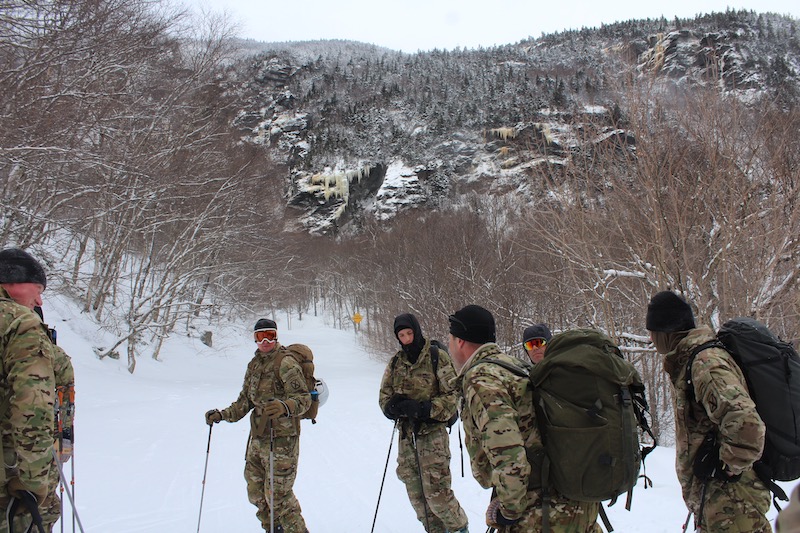
When we crested Spruce Peak, the wind was gusting to 40 miles per hour and the chairlifts were swinging—empty. The trails had been scoured into bright, blue ice. After consulting a trail map and talking with Charlie Flood, a Stowe ski patroller in their ranks, they cheerfully ripped their skins off, stowed them in their jackets and disappeared down the slopes into the swirling snow.
Most backcountry skiers would have been deterred by the weather, but these guys were psyched.
Their mission? To train for the Edelweiss Raid, a mountaineering competition for teams of military personnel that blends skimo racing and mountain warfare tactics in a harrowing two-day race through the Tyrolian Alps on February 27 and 28. This team is the first group of soldiers the U.S. has ever sent to the race in its 10-year history—and six of the eight are Vermonters.
Training the Toughest
Vermont’s Edelweiss Raid team represents some of the most highly trained mountaineers in the U.S. Military.
Drew Gelinas is a coach for the U.S. Army Biathlon Program and former U.S. Ski Team coach. Will Timmons is a former national champion collegiate Nordic ski racer for the University of Wyoming and Rob Niles, a U.S. Army Mountaineer and sugarmaker from Marshfield, has summitted the 22,349-foot Himalayan peak Ama Dablam. The team also includes Major Nathan Fry, Tim McLaughlin, Micah Nevard, Scott Stone and freeskier Pantelis Geralis.
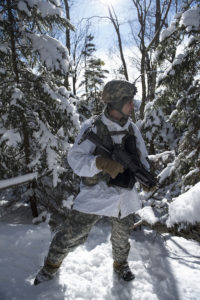
All have trained with the Vermont Army National Guard at the Army Mountain Warfare School in Jericho, the U.S. Army’s premier training center for mountain operatives since 2003.
“A lot of people, even those who live in Jericho have no idea what comes through our door at the Mountain Warfare School,” says Major Fry, Training Division Chief since 2014 and the team’s leader. “Navy Seals? Airforce? Paramedics? The FBI? They all train here, with Vermont National Guard instructors.” When I sat in on a land navigation course at the school this month, I asked a participant what unit he was with. He cautiously responded, “I’m with Special Ops.”
The Green Mountains have long been a training ground for the United States’ Armed Forces. The 10th Mountain Division was founded here in 1943 with the help of Stowe ski patroller and National Ski Patrol founder Charles “Minnie” Doyle. The division, comprised of many Vermonters, went on to win major battles in some of the most technical terrain American troops encountered in World War II. The unit was disbanded during the Cold War and has since been reinvented as a light infantry brigade.
Vermont’s modern tradition of military mountaineering starts in 1983, when the Vermont Army National Guard volunteered to host what was then an experimental unit called Alpha Company at Camp Ethan Allen in Jericho. The camp was already home to the army’s biathlon team, and many of the early recruits were biathletes and skilled recreational mountaineers and skiers.
In 1994, the Vermont Army National Guard Mountain Warfare School was designated the sole producer of the Skill Qualification Identifier E: the military’s formal certification for mountain warfare skills. For years, members of the Vermont National Guard served as instructors at the school, teaching visiting units and soldiers from across the country how to rappel, navigate in the mountains, rock and ice climb, ski tour, evacuate casualties in vertical terrain and more. In 2003, the school came under ownership of the Army, but is still operated and staffed by the Vermont National Guard.
Why Vermont?
The scrappy Vermonters have built a reputation for producing highly trained soldiers. In 2005, the Army sent instructors from the Vermont National Guard to provide mountain warfare and cold weather training to U.S. and Afghan special operations forces in Afghanistan, home to one of the tallest mountain ranges on Earth: the Hindu Kush. The 500-mile-long range includes Noshaq, a nearly 25,000-foot-high peak. At 6,000 feet, the country’s capital, Kabul, is one of the highest in the world, a city bounded by mountains.
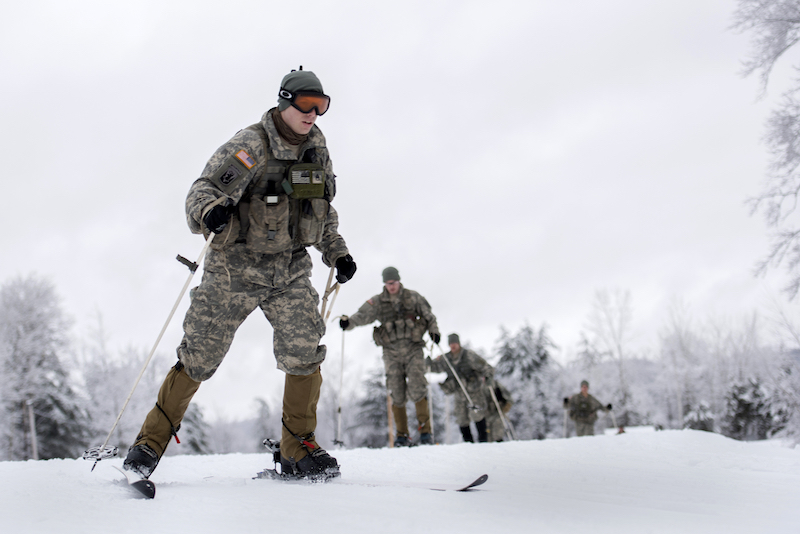
Sargent Jeremy Neskey was one of the guardsmen deployed to Afghanistan in 2010. Neskey, a paramedic from southern Vermont, has also worked search and rescue in Alaska’s Denali National Park and for Yosemite Search and Rescue.
In 2010, Neskey found himself charged with retrieving an injured soldier from one of the worst possible places: an exposed desert summit in Afghanistan, out of reach of a Black Hawk helicopter and in a combat zone. He helped stabilize the patient, and then carry them via a litter over a red rock ridge with steep, technical terrain. “We were on a ridgeline that was like the top of Mt. Mansfield, but at 9,000 feet in the desert. There were no trees, no cover, just sun-baked dry rock like what you’d find in Arizona.” They carried the litter down rotten, crumbly bedrock for what felt like ages, until they finally made it to the valley.
“I’d trained for it and was able to help someone,” he said simply. Now he teaches other army personnel to do the same, and also teaches wilderness rescue skills and emergency medicine. He teaches students to rig three-to-one hauling systems, largely using the gear they carry in their standard rucksack. “The challenge is that you can’t waste any weight or add to what a company would be carrying,” says Neskey. “Here, we teach people to set up a standard military litter and then how to move it in 45-degree terrain.”
Though Neskey is not competing in the Edelweiss Raid, many of the team are his fellow instructors. They carry a similar degree of expertise. And for those who have not seen mountain combat, Austria will put their mastery of those skills to the test.
What Does It Take?
“If you look across the world, virtually every country has mountainous terrain,” says Mountain Warfare School Commander Matthew Brown. “What we teach here are the individual skills necessary to operate that collective group in mountainous terrain. When they are put into this scenario in a combat situation,
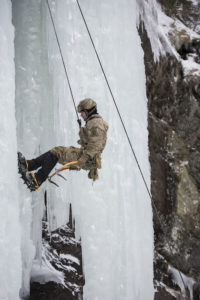
we don’t want the environment to be the enemy.”
Each year, about 700 soldiers are selected by their unit leaders to attend the Army’s Mountain Warfare School. Admission is competitive. The school offers about ten Basic Military Mountaineering courses annually, with 64 students per class. Anywhere from four to 12 are dropped each course.
The goal? To train soldiers who are already skilled in infantry (riflery, moving as a group, setting up observation towers, securing terrain, rescuing casualties on the ground) and have passed a standard army physical fitness test to do those same tasks in the mountains. Often that means securing a mountain pass and moving supplies or people through it or rescuing a casualty.
Generally speaking, this work does not involve the type of feats performed by Sylvester Stalone in the 1993 movie “Cliffhanger.” Soldiers aren’t usually moving on skis, and they certainly aren’t shooting from them.
During the two-week Basic Military Mountaineering course, soldiers start class as early as 5:30 a.m. each day and finish late in the night. They slog through the forests in the cold and wet, navigating the maze of gullies and ridges that dominate the topography near Camp Ethan Allen. The point is to teach soldiers to operate in the worst conditions they would encounter in combat. At the end of each skill session, you either pass or you don’t—regardless of your rank.
For example, halfway through the course, soldiers have one week to learn 17 knots, after which they are given 30 seconds to tie each and explain its purpose to an instructor.
In the land navigation exam, soldiers race against the clock to plot and navigate to a series of waypoints scattered across a course that covers two mountains.
These exercises, like all the others, are designed to prepare students for the final exam: The Mountain Walk. At the end of the course, instructors guide students, wearing full ice climbing gear, up a low angle gully in Smugglers’ Notch and test their skill at moving on a fixed line. Students must rig and ride a rappel and demonstrate to instructors that they can make decisions in an exposed setting.
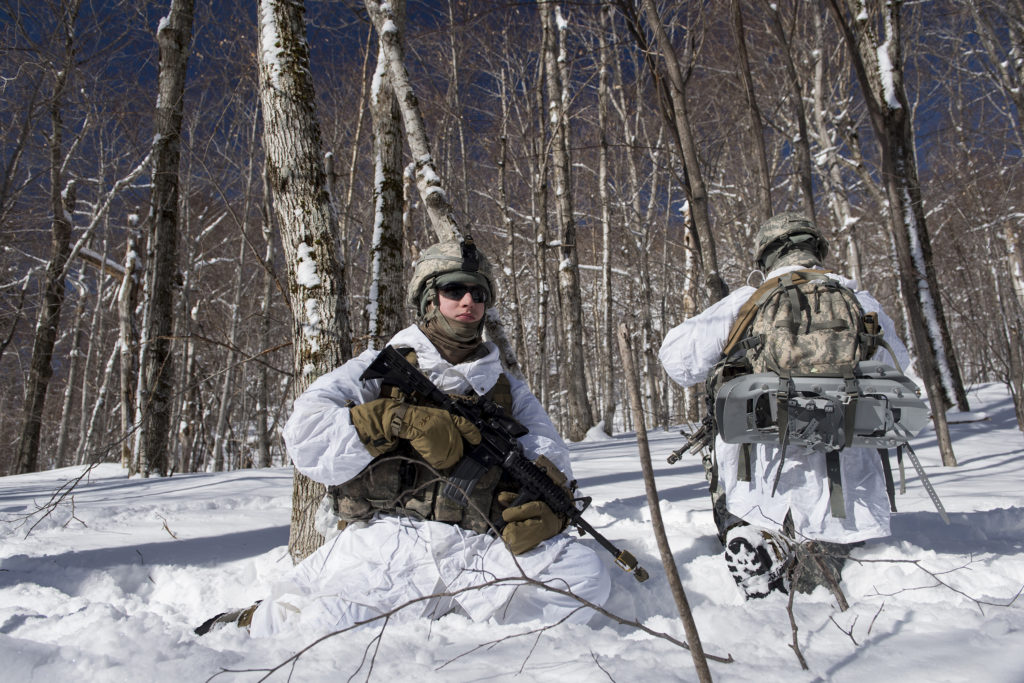
On March 14, 2018, during a Mountain Walk test, six Vermont Army National Guard soldiers were caught in an avalanche that carried three of them nearly 900 feet and two students 500 feet over a 50-foot cliff band in Smugglers’ Notch. Five were injured and two spent multiple nights in the hospital with injuries that ranged from fractures to contusions and lacerations.
A report released by the Army in September 2018 stated that at the time of the accident, “no one in the squad was wearing a beacon, shovel or probe.” The same report indicated that just two days before the accident on March 12th, “the Advanced Military Mountaineering Course primary instructor first identified a ‘weak layer’ in the snowpack…one of several elements of, or precursors to, avalanche conditions.”
Following the accident, Army Mountain Warfare School hired Acadia Mountain Guides, a private guiding company from Maine, to help them develop better risk management.
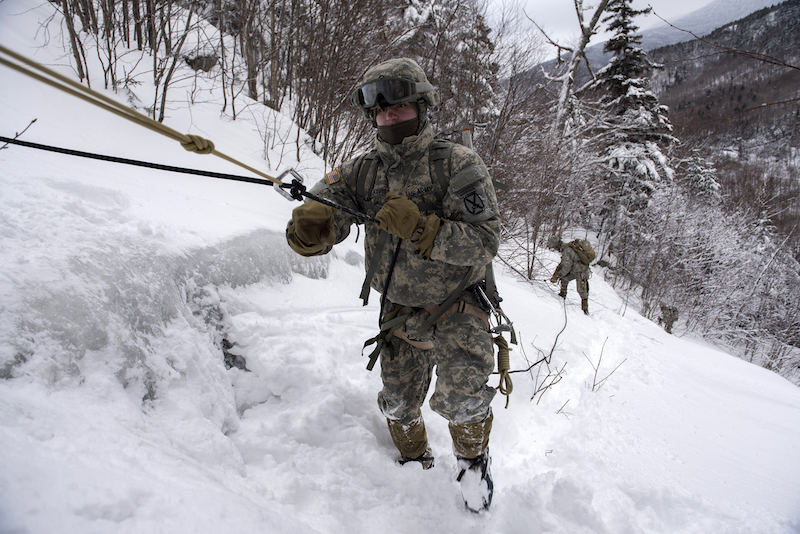
“Managing risk is a daily event for us,” said Commander Brown. “We make sure our instructors are very well trained in the potential hazards, that they meet all of the same certifications as civilian guides so we aren’t putting people in bad situations. But you can never completely take the risk out of your training—otherwise it’s not training.”
According to Commander Brown, the Army’s intent is not to send every soldier to Vermont to become an expert rock climber, ice climber or skier. It’s to train select soldiers headquartered in Vermont, the 86th Infantry Brigade Combat Team (Mountain), to be able to teach their units those skills should they need them.
The Best of Military Mountaineering
It was Major Nathan Fry who first pushed for the U.S. to send a team to the Edelweiss Raid. “I was at a training in Austria, and some of my colleagues over there were like, ‘Hey, how come you guys never send anyone?’”
Fry saw the Raid as an opportunity to show the Army, and possibly the country as a whole, how important mountain warfare training is. Commander Brown was convinced.
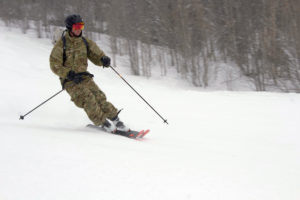
“This training is essential, because it ensures that we are not sending units into combat that do not have training in mountain warfare—something that has happened in our military history,” says Brown.
According to Fry, who has a master’s degree in Environmental and Natural Resources from the University of Vermont, the Edelweiss Raid is part elite competition, part trade conference and part opportunity to swap training protocols and ideas with European allies. The event calls itself “the unofficial World Championships for mountain troops,” and features a high alpine race over 40 kilometers, with 4,000 meters of elevation gain over two days in the Austrian Alps.
Unlike in a traditional ski mountaineering race, the soldiers camp in the mountains. Each member is required to carry a rifle and a rucksack and the team has to carry an evacuation sled. Over the course of the race, teams are tested on 13 tasks, including avalanche rescue, technical mountaineering skills, throwing grenades and making a ski descent roped together as a group of eight, a feat that is supposed to mimic glacier travel in a combat scenario. Most first-year teams drop out and the competition is stiff.
“There is an all-female team competing this year from Russia that has an incredible roster of athletes,” said Fry, “I think they will kick our butts.”
The goal? To be the first rookie team in the race’s history to finish and to represent the best of U.S. military mountaineering.
The Few, The Strong
When he isn’t instructing full-time at the Mountain School Fry is a lecturer at UVM. He’s a medium-height guy with a face that is a more weathered from the elements than you’d expect for his age.
Fry, 34, grew up in rural Louisiana. “I’m lucky I survived my first experience with the vertical world,” he says, recalling a day when he rappelled with a figure eight belay device and a piece of rope he and his friends stole off of a grain silo. Compelled by the discipline and structure the Army offered, he joined as an infantry officer after college. He moved to Vermont to take a job as a full-time instructor at the Mountain Warfare School in 2013, after a stint working for the National Forest Service as a deputy district ranger in New Hampshire’s White Mountains.
“The Army has afforded me opportunities I never would have had as a civilian. It’s led me to climb in Europe and South America. I’ve been to the Arctic twice, and I work with some incredible mountaineers,” says Fry, who now lives in Huntington with his wife and kids. “I think you’ll hear that from a lot of the guys on the team. It takes resources to be able to gain these skills, and the Army offers some incredible opportunities.”
As the team’s initiator and co-captain, Fry recruited the racers for the Edelweiss Raid. Drew Gelinas, a former coach for the U.S. Ski Team’s Nordic Combined program, was an obvious choice. “These skills are important,” says Gelinas. “It doesn’t matter how advanced technology gets—every fight comes down to people being on the ground.”
Pantelis Geralis is a Burr and Burton Academy graduate who has made a career with the Colorado National Guard teaching fellow soldiers skills he’s gained through his continued relationship with the Mountain Warfare School in Jericho. “I started skiing in terrain parks, but I eventually found my way to the backcountry,” says Geralis, who is now a competitive skimo racer. “We want to show people that the 10th Mountain Division is still here, that this is something we, as Americans, can do and are good at.” He says Vermonters may have a leg up on the rest of the Army. “The cold almost adds an extra enemy. It’s an element that you can sometimes use to your advantage as much as it can be used against you.”
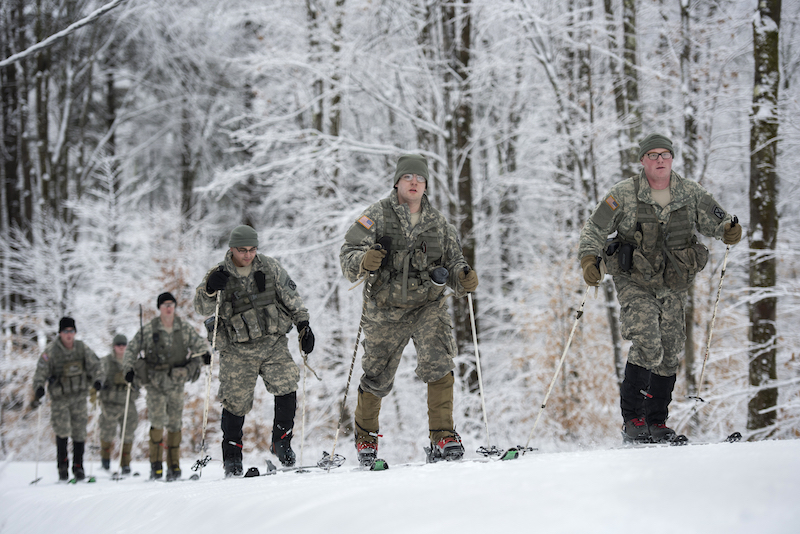
Another obvious choice? Team co-captain Tim McLaughlin, a Mountain Warfare School instructor who lived at the base of Mt. Mansfield for the better part of 15 years. He started mountaineering in Oregon’s North Cascades while serving in the Ranger Battalion and joined the Vermont National Guard’s Mountain Battalion after his active duty was up in 2007.
“When I first started working at the school in 2007, I was living in a van. I’d park it down at the lot at Mad River Glen for a week at a time and ski for days as soon as the teaching season ended.” Now, Fry says, McLaughlin is one of the strongest backcountry skiers on the team.
For his part, McLaughlin is always thinking about how he would move if he were in combat. This goes back to his days in Afghanistan. “Even if I am climbing recreationally with guys from the school, I’ll try to think about where I’d want to be.”
The Edelweiss raid
On February 27, 2019 the eight soldiers raced onward across the Tyrolian Alps, sweating in the hot sun. They could see the finish for the first day. Moving single file, they pushed across the ridge to the top of a steep slope. They were gassed. Nearly 30K into the Edelweiss Raid, Austria presented the one thing their training in subzero blizzard conditions in Vermont couldn’t prepare them for: miles of buttery-soft snow under bluebird skies.
With M-4 rifles stowed against their packs, the soldiers maneuvered into a line, passing a rope along and tying in as they went. They’d assessed avalanche danger, simulated a casualty extraction on skis and rappelled from makeshift anchors. Now, they faced a daunting task: to ski four kilometers as a group of eight, roped up. “Ready?” called McLaughlin. “Go!” The soldiers side-slipped and snow-plowed gingerly to the base. Miraculously, they passed four teams.
The next day, Niles, the sugarmaker from Marshfield and a long-range riflery instructor for the National Guard, made an impressive performance in the shooting competition. Fry said, “In the end, it was the Vermont-hardened mountain instructors on our team who helped us show what we could do.”
The Vermonters couldn’t help but hoot as they skied down steep, mashed potato snow to finish 13th of 23 teams.

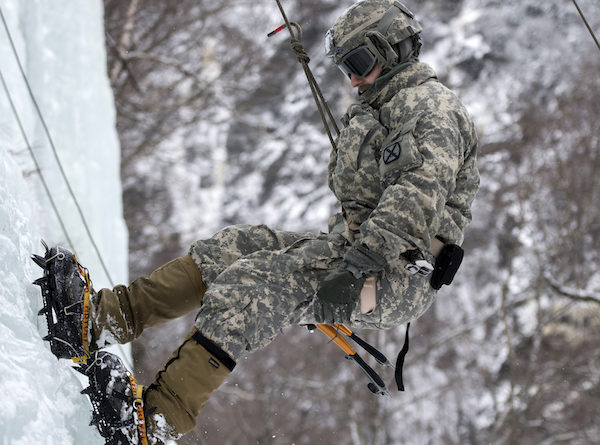
Great article. Thank you. I thought the 10th Mountain Division was started in Hale Camp in Colorado. At least that is what is portrayed in a Warren Miller film that they show at the Colorado Ski Museum
Thanks for reaching out Carol Ann. The first “camp” and physical location of the 10th Mountain Division was at Camp Hale in Colorado but the idea for it was generated here in Vermont. Here’s a link to a previous story we ran on the history of Vermont’s involvement with the 10th Mountain Division:
GREAT ARTICLE.. FUN READ
Very interesting.The 172nd was armor when I was in it as a scout and later a tank commander. Not much use in the mountains! Great for opposing Soviet tanks in Germany. Always been proud of the VT National Guard, Army and Air Force.
Pingback: VT SKI + RIDE Wins General Excellence in New England – VT SKI + RIDE
Pingback: A Skier Dies and a Tragic Rescue – VT SKI + RIDE